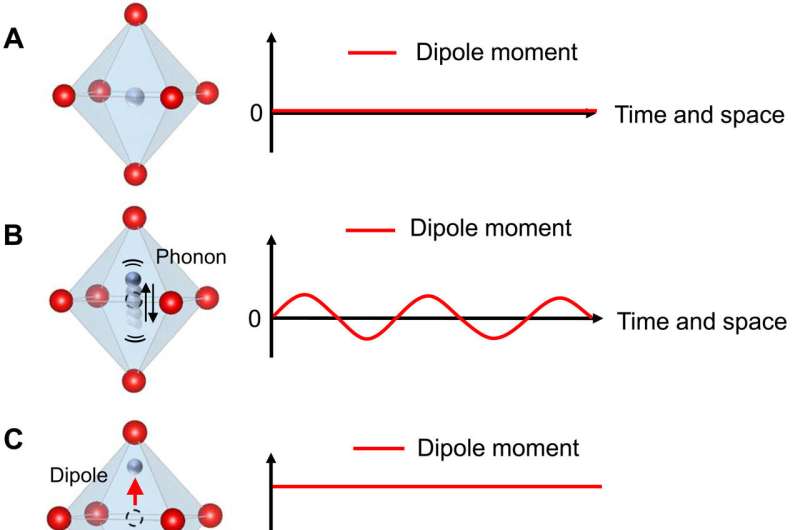Scientists report on a quasiparticle that can transfer heat under electrical control


Scientists have found the secret behind a property of solid materials known as ferroelectrics, showing that quasiparticles moving in wave-like patterns among vibrating atoms carry enough heat to turn the material into a thermal switch when an electrical field is applied externally.
A key finding of the study is that this control of thermal conductivity is attributable to the structure of the material rather than any random collisions among atoms. Specifically, the researchers describe quasiparticles called ferrons whose polarization changes as they “wiggle” in between vibrating atoms—and it’s that ordered wiggling and polarization, receptive to the externally applied electrical field, that dictates the material’s ability to transfer the heat at a different rate.
“We figured out that this change in position of these atoms, and the change of the nature of the vibrations, must carry heat, and therefore the external field which changes this vibration must affect the thermal conductivity,” said senior author Joseph Heremans, professor of mechanical and aerospace engineering, materials science and engineering, and physics at The Ohio State University.
“People tend to think atom vibrations are a given fact and don’t respond to an electric field or a magnetic field. And we are saying you can affect them with an electric field.”
With the use of a simple external electrical stimulus, the thermal conductivity in this type of material can be changed at room temperature rather than at the extremely low temperatures required to control most candidate materials for solid-state heat switches, enhancing the possibilities for real-world applications of the technology, the researchers say.
The study is published today (Feb. 1, 2023) in the journal Science Advances.
The material used in the study is a common lead zirconium titanate ceramic belonging to a class of materials called piezoelectrics, which change shape when an electric field is applied to them or produce an electrical charge under mechanical stress.
Ferroelectrics, a subset of piezoelectrics, are materials in which the electrical charges on the atoms can spontaneously form electrical dipoles that all align in the same direction, forming what is known as polarization. These dipoles can be switched by an external electric field.
Until now, scientists had not formally written down how this polarization will move when heat is applied. In this new article, this motion is described by introducing the quasiparticle—called a ferron—that carries waves of polarization and heat at the same time. The ferron is sensitive to an external electric field, and that means the application of an external electrical field can turn the material into a heat switch.
“The quasiparticle has always been there. It just hasn’t been identified and measured,” said first author Brandi Wooten, a Ph.D. student in materials science and engineering at Ohio State.
Wooten likened ferrons’ behavior to a stadium wave, with each sports fan representing a cell of atoms collected together in a crystal.
“You have all these atoms, and they have this special dipole—an atom with an electrical charge that moves up and down creates a dipole. You can think of people’s hands going up doing the wave as the dipole’s strength—if their hands are up, it’s really strong. If they’re a little bit down, it’s weaker, and if they’re all the way down, it’s negative,” she said. “That’s the dipole’s strength. We found that these special waves carry both heat and polarization, and we labeled them ferrons.”
This heat-transferring property is induced by the electric field through a phenomenon known as the piezoelectric strain: The lattice contracts or stretches when the voltage is applied, with atoms and forces between them moving back and forth, ultimately changing the mechanical properties of the material and, as a result, changing its thermal conductivity, said Heremans, also an Ohio Eminent Scholar in Nanotechnology.
“The ferron is also sensitive to strain in the solid. Since the ferron carries heat, that makes the amount of heat carried dependent on the electrical field,” he said. “So we wrote a new theory that relates an external electric field, the strain it induces in a ferroelectric, and ultimately how this strain affects the thermal conductivity.”
The theory is predictive, so researchers can now use it to find materials where the effect is much larger, ultimately leading to materials where it is large enough to be used in heat switches in everyday applications, like collection of solar power.
The application of an electrical field to the material produced a 2% difference between maximum and minimum conductivity—as the new theory predicted would be the case. A series of experiments quantifying the atomic vibrations through measuring the velocity of the material’s sound waves and equilibrium and transport properties validated “that this all depends only on the material structure, not necessarily what’s scattering the vibrations,” Wooten said.
The researchers are now studying other materials that might increase that change in thermal conductivity by up to 15%, as the new theory predicts.
“Any application depends on us finding a material where the effect is much larger,” Heremans said. “We are looking for materials that have the right parameters.”
Additional co-authors include Ryo Iguchi and Ken-ichi Uchida of the National Institute for Materials Science in Japan; Ping Tang and Gerrit Bauer of Tohoku University; and Joon Sang Kang of Ohio State.
More information:
Brandi Wooten et al, Electric-field dependent phonon spectrum and heat conduction in ferroelectrics, Science Advances (2023). DOI: 10.1126/sciadv.add7194.
Provided by
The Ohio State University
Citation:
Scientists report on a quasiparticle that can transfer heat under electrical control (2023, February 1)
retrieved 1 February 2023
from https://phys.org/news/2023-02-scientists-quasiparticle-electrical.html
This document is subject to copyright. Apart from any fair dealing for the purpose of private study or research, no
part may be reproduced without the written permission. The content is provided for information purposes only.



